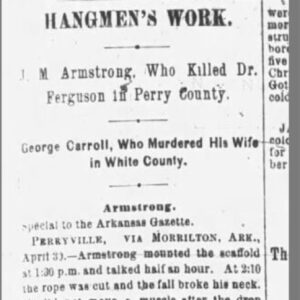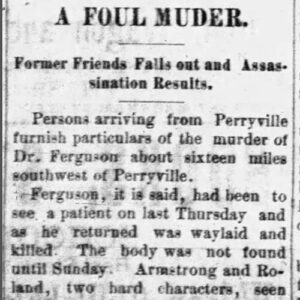calsfoundation@cals.org
J. M. Armstrong (Execution of)
J. M. Armstrong, convicted in a doctor’s killing that he claimed was in self-defense, was hanged at Perryville (Perry County) on April 30, 1886, one of two Arkansans to die on the gallows that day.
On February 11, 1885, Dr. Thomas Ferguson failed to come home after visiting a patient, though his horse returned. His body was found on a road about sixteen miles southwest of Perryville the next day by a search party led by J. M. Armstrong. Suspicion fell on Armstrong and John Roland, two “hard characters” who had been seen heavily armed in the area on the previous day. “The crime created so much excitement that on the day of the burial a posse arrived at the grave and placed every man present under arrest,” but Armstrong slipped away.
Governor Simon Pollard Hughes offered a $200 reward in July for Armstrong’s arrest and conviction, and he was eventually captured. Roland was tried in the case and sentenced to twelve years in the penitentiary for aiding and abetting Armstrong in the crime prior to Armstrong’s trial in mid-March 1886. After hearing the testimony, a Perry County jury deliberated about two hours before finding Armstrong guilty of first-degree murder on March 18; the judge pronounced that “you shall hang by the neck until you are dead, dead, dead, and may the Lord have mercy on your soul.” A local correspondent to the Arkansas Gazette noted that it was the first death sentence ever issued in Perry County and “will probably teach a lesson that will not soon be forgotten.”
Originally scheduled for March 30, Armstrong’s execution was apparently delayed for a month for appeals. An Arkansas Democrat reporter visited Armstrong in the state prison, where he was being held for safe keeping, and the condemned man gave his version of events.
Armstrong said Ferguson was treating his wife, but the medicine he prescribed was too strong for her, so he and Roland went to Ferguson’s house to ask him about it. Ferguson’s wife told them he was on a house call, so they left to meet him there, hunting turkeys along a creek as they went.
When they encountered Ferguson, Armstrong said he asked him to see his wife, and the doctor cursed “damned Arkansas hoosiers who would not take medicine according to directions.” The two began quarreling, and Ferguson pulled a knife, got off his horse, and swung the blade at Armstrong, who backed away while threatening to shoot the doctor if he did not stop. Roland shot at him but missed, and as Ferguson grabbed the barrel of Armstrong’s gun he fired, killing him.
Armstrong said they left Ferguson’s body in the road and sent his horse home. He and Roland agreed to not tell anyone what had happened, he told the reporter, but Armstrong maintained the killing was in self-defense.
On April 30, 1886, Armstrong ascended the gallows at 1:30 p.m. and talked to the crowd of around 4,000 people, including his wife and two children, for thirty minutes. At 2:10 p.m. “the rope was cut and the fall broke his neck. He did not move a muscle after the drop fell.” The Gazette concluded: “Perry county is relieved of a desperado who has been a constant menace to its peace.”
George Carroll, convicted of murdering his wife, was also executed on April 30, 1886, being hanged at Searcy (White County).
For additional information:
“Arkansas State News.” Osceola Times, July 25, 1885, p. 2.
“Arkansas State News.” Osceola Times, March 27, 1886, p. 2.
“For Safekeeping.” Arkansas Gazette, March 20, 1886, p. 5.
“A Foul Muder [sic].” Arkansas Democrat, February 27, 1885, p. 2.
“Full Details of the Arkansas Murders.” Kansas City [Missouri] Star, April 30, 1886, p. 1.
“Hangmen’s Work.” Arkansas Gazette, May 1, 1886, p. 1.
“Perryville, Ark.” Arkansas Gazette, March 18, 1886, p. 3.
“Perryville, Ark.” Arkansas Gazette, March 20, 1886, p. 2.
“Perryville, Ark.” Arkansas Gazette, March 26, 1886, p. 3.
“To Be Hanged.” Arkansas Democrat, April 26, 1886, p. 5.
Mark K. Christ
Central Arkansas Library System
 Law
Law Post-Reconstruction through the Gilded Age, 1875 through 1900
Post-Reconstruction through the Gilded Age, 1875 through 1900 Armstrong and Carroll Execution Story
Armstrong and Carroll Execution Story  Armstrong Murder Story
Armstrong Murder Story 




Comments
No comments on this entry yet.